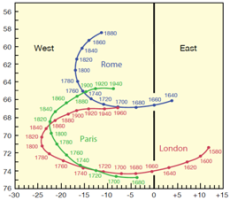Research projects
Find out about our research projects in the area of geomagnetism and palaeomagnetism.
Current projects
Geomagnetically induced currents and the risk to the New Zealand power network
During times of intense solar activity, electric currents induced in the ground by the changing magnetic field cause a potential hazard to power systems. A funded three-year PhD project is available as part of a collaborative project between Victoria University of Wellington and the University of Otago. This project seeks to quantify this risk for the New Zealand power network.
The student will:
- develop a three-dimensional electrical conductivity model for New Zealand which can be used to predict the induced electric fields
- make measurements of the time varying magnetic field and various critical locations in the South Island and investigate the correlation of these with both induced electric fields and measured GIC in the power network.
Interested students should contact Dr Malcolm Ingham.

Malcolm Ingham
Chronostratigraphy and cyclostratigraphy of sea-level cycles recorded in mid-pliocene shallow-marine sediments, Wanganui Basin, New Zealand
The 5 km-thick uplifted sedimentary record in Wanganui basin, New Zealand, is regarded as one of the most detailed and complete shallow-marine records of global sea-level change. It records the sedimentary response of the shoreline and continental shelf to nearly every individual orbitally-paced glacio-eustatic sea-level cycle in the Plio-Pleistocene deep ocean oxygen isotope record.
The PhD project advertised here forms part of an international project to reconstruct the frequency and magnitude of global sea-level change during the Mid-Pliocene warm period between 3.6-3.3Ma from two new 500-metre deep cores overlapping in age, but representing different paleo-shelf locations, in Wanganui Basin.
The aim is to provide quantitative estimates of global mean sea-level for a number of well-documented ‘warmer-than-present’ interglacials. This will require:
- The development of an integrated chronostratigraphic framework from tephrostratigraphy, paleomagnetic stratigraphy, biostratigraphy and cyclostratigraphy.
- The development of a paleobathymetry curve for each drill core record using a census of extant benthic foraminifera and a sediment grainsize water-depth relationship.
- The development of a benthic oxygen isotope stratigraphy
- Quantitative 2-dimensional backstripping remove the influences of sediment compaction and subsidence and produce an apparent sea-level curve.
- A correction for glacio-hydro-isostatic influences to produce global mean sea-level estimates.
The successful candidate will:
- Undertake a paleomagnetic analysis of the drill cores in order to develop a magnetostratigraphy constrained by numeric ages on tephra and biostratigraphy.
- Conduct physical property scanning of sediment cores and develop a cyclostratigraphic interpretation
- Undertake 2-D backstripping procedure to reconstruct sea-level cycles. Applicants should have completed an MSc (with hons) or BScHons in geosciences, with a demonstrated aptitude for numerical methods.
The PhD student will be enrolled:
- Either at University of Otago at the Department of Geology with co supervision provided by Victoria University of Wellington (Antarctic Research Centre and School of Chemical and Physical Sciences). Candidates should apply for the University of Otago Postgraduate PHD scholarship worth $90,000 over three years.
- Or at Victoria University of Wellington in the School Geography, Earth and Environmental Sciences with co-supervision provided by School of Chemical and Physical Sciences (Victoria University of Wellington) and University of Otago (Department of Geology). Candidates can apply for Victoria University Postgraduate PHD scholarship worth $90,000 over three years.
For more information, contact:

Gillian Turner
Past projects
Palaeomagnetic secular variation in the southwest Pacific
Marsden funded research project (2012–2014): Unlocking the secrets of the geodynamo—the southwest Pacific key

This project was a collaboration with Prof Andrew Roberts, (Australian National University), Dr Mimi Hill (Liverpool University) and Prof Peter Sheppard (Auckland University).
The overall aim of this project was to learn as much as we can about the geomagnetic secular variation in the SW Pacific region over the past 10,000 years. The new data collected filled the current gap in datasets used for producing global models of the field, leading to a better understanding of the geodynamo, core dynamics, and core-mantle boundary interactions.
This research also enabled the construction of a high-resolution regional field model which will find application in dating Holocene sediments and archaeological materials. The palaeomagnetic work involved both archaeomagnetic studies on Pacific Island pottery artefacts and Maori hearths, including intensities, and palaeomagnetic work on cores of lake and marine sediments.
(Graph shows geomagnetic secular variation. Changes in the direction (declination and inclination) of the field recoded at observatories in London, Rome and Paris over the past 400 years.)
A PhD studentship was available to work on the palaeomagnetism of lake and marine sediment cores and field modelling.
An MSc studentship was available for 2013, to work on the magnetic records, particularly the intensities, of archaeological materials.
Geomagnetic polarity reversals

What happens when Earth’s magnetic poles flip?
In this project we are sampling through the records of several polarity reversals in sediments that accumulated rapidly on the seabed but which have been uplifted due to subsequent tectonic activity, and are now exposed in cliffs along the rivers of the Wanganui Basin and elsewhere. The goal of this project is to obtain multiple high-resolution records of the field changes through these reversals, and so gain insight into the reversal process.
Tectonics in plate boundary zones
New Zealand lies on the boundary between the Pacific and Australian tectonic plates. Palaeomagnetism is used within the boundary zone to delineate blocks that are not attached to either stable plate, and to measure the rotation of these blocks over time with respect to the rigid plates.
For more information, contact Dr Gillian Turner.

